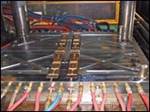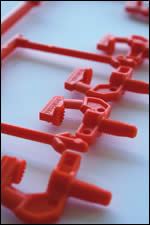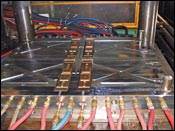Multi-Cavity Mold Issues Solved with Melt Rotation Process
Toolroom supervisor shares his experience with a rheological control solution to some obvious and some not-so-obvious challenges with product and color variations in a multi-cavity mold.
At first glance, injection molding low water flow volume, micro spray irrigation products for the citrus growers industry and retailers like Lowes, Ace Hardware and True Value might not seem to be too challenging. Even molding products that are offered with as many as eight different spray patterns for each product, most molders might not view this as overly difficult. But think again!
When the precision requirements of the spray pattern are considered and the molds and the molding process have to produce eight different part styles, each with up to eight different nozzle configurations (which are molded in eight unique colors for each product size and type), the problems, molding complexities and costs begin to mount. These product and color variations in a multi-cavity mold present some obvious and some not-so-obvious challenges.
At Maxijet, Inc.—one of the world’s most renowned molders of low water volume irrigation products—parts molding previously required a unique process setup for each configuration to avoid common molding problems. These included excessive problems with flash, sinks and shorts.
Due to previous problems, certain cavities had to sometimes be blocked in order to complete the production run and get parts to the customer on time. These process variations and quality issues required a fair amount of process babysitting, and the regular scrap and blocked cavities reduced operational efficiencies. These involved constant adjustments and tweaking. So, they sought ways to overcome these challenges.
Melt Rotation Process Enhancement System
Now, thanks to recent advances in injection molding process technology, Maxijet, Inc., has put this molding challenge to rest. And, note sources at Maxijet, a new MeltFlipper® melt rotation process enhancement system from Beaumont Technologies has enabled them to produce better and more consistent products, plus saved them money as well. The company confirmed reductions in scrap by as much as 33 percent. Added to this are savings realized from reduced maintenance and downtime.
Tim Wert, Toolroom Supervisor at Maxijet, notes that cost savings due to increased cavity utilization, reduced setup and molding times, not to mention the increase in quality molded parts, are significant. Based on molding millions of parts, the return on investment was only a few short months, with an actual 25 percent ROI. He does note that the Maxijet agricultural system parts cost very little, so for another firm using MeltFlipper technology and molding larger and pricier parts, the ROI could be achieved considerably faster, earning them a far greater return. It is also important, he adds, that this return comes every year that the mold is in production.
According to Maxijet, a company owned by the Thayer family, a fifth generation of Florida citrus growers, the development of a micro-spray jet technology to more efficiently enable growers to water their newly planted citrus trees has had extremely positive effects on the industry—and now consumers. Their products have become the standard of quality in low-volume irrigation. The patented design of the Maxijet brand of nozzles increases a product’s yield, saves water and applies water directly to the tree roots. Watering, coupled with fertigation by injecting liquid fertilizer through the jets, and in the winter months by providing frost protection by increasing the dew point during freezing temperatures, have made a difference worldwide.
Wert recalls, “Seeing our products go from the idea stage, through development and the molding of the finished product was a most gratifying experience. However, our ability to mold 100 percent quality products on a consistent basis easily created a major hurdle, at least temporarily. That’s when the low-cost licensed technology called MeltFlipper® system turned out to be a great investment, which ended up paying for itself in just a few short months,” he adds.
Advanced Molding Technologies
From the very start when Maxijet started running this mold with the multi-configured, multi-part nozzle and multi-colored offerings, the toolroom supervisor remembers, “The process needed constant tweaking to try to eliminate short shots or flash within the spray pattern of the various parts produced from our multi-cavity molds. Any irregularities within the spray pattern feature would affect how the water would spray.”
But, to the dismay of those at Maxijet charged with troubleshooting the molding process, changes made to the mold (often involved blocking the flow to certain cavities) to improve the quality problems in one cavity would sometimes cause another cavity to develop a quality issue.
Thus, Maxijet had to develop a different process setup for every spray pattern, which resulted in longer mold setup times. Fortunately, reflects Tim from their Florida headquarters, they anticipated these molding complexities and from the outset had been looking into rheological control technologies to help optimize the process and part quality. The solution came about as a result of Wert attending one of the free molding seminars offered by Beaumont Technologies, Inc. (Erie, PA) that explains the fundamental sources of mold filling variations and the technology driven to solve the root cause of those variations.
ROI Makes Investment Prudent
The patented MeltFlipper product, which is licensed to users for a single mold, a bundle of molds, or on an annual site license basis, offers a multi-dimensional approach to material flow properties that provides a true balance of pressure, temperature, viscosity and material properties throughout the entire mold.
Beaumont Technologies provided data to Maxijet that showed how the guaranteed MeltFlipper technology had overcome similar issues with all types of resins, including the acetal resin used in Maxijet’s nozzles.
The overwhelming success of their first experience with MeltFlipper technology now has the firm pursuing the addition of the technology to three additional tools experiencing similar issues. The primary goal for all Maxijet products is cavity uniformity because the spray pattern is critical and all of the parts from the various product sizes and corresponding colors must fit together precisely within the final assembly. The toolroom supervisor reports that cost savings because of reduced setup and molding times, not to mention the increase in quality-molded parts, continues to be significant.
Company officials at Maxijet credit their implementation of advanced molding technologies, including MeltFlipper technologies, as a means for them to improve the quality of the product offered to their customers, and a contributor to their growth over the past four to five years.
Related Content
Considerations for Mold Base Material Selection
Choosing the right material can greatly affect the profitability and cost of your application.
Read MoreThe Trifecta of Competitive Toolmaking
Process, technology and people form the foundations of the business philosophy in place at Eifel Mold & Engineering.
Read MoreThe In's and Out's of Ballbar Calibration
This machine tool diagnostic device allows the detection of errors noticeable only while machine tools are in motion.
Read MoreOEE Monitoring System Addresses Root Cause of Machine Downtime
Unique sensor and patent-pending algorithm of the Amper machine analytics system measures current draw to quickly and inexpensively inform manufacturers which machines are down and why.
Read MoreRead Next
Rebuilding Tools with High Performance Material
High-performance alloy offers a unique combination of thermal conductivity and strength—providing numerous benefits to the moldmaker and molding process.
Read MoreReasons to Use Fiber Lasers for Mold Cleaning
Fiber lasers offer a simplicity, speed, control and portability, minimizing mold cleaning risks.
Read MoreAre You a Moldmaker Considering 3D Printing? Consider the 3D Printing Workshop at NPE2024
Presentations will cover 3D printing for mold tooling, material innovation, product development, bridge production and full-scale, high-volume additive manufacturing.
Read More








_300x250 4.png;maxWidth=300;quality=90)











.jpg;maxWidth=300;quality=90)









.jpg;maxWidth=970;quality=90)